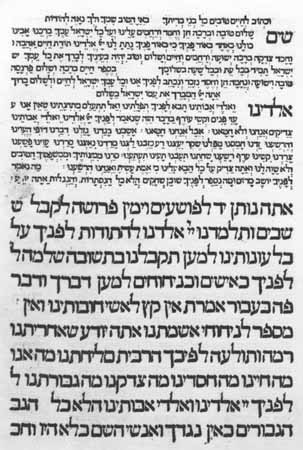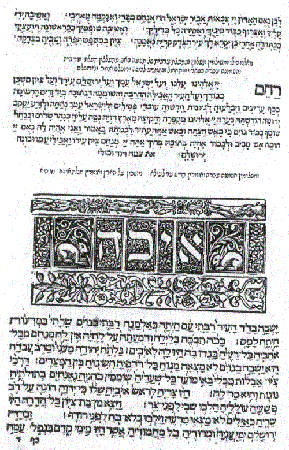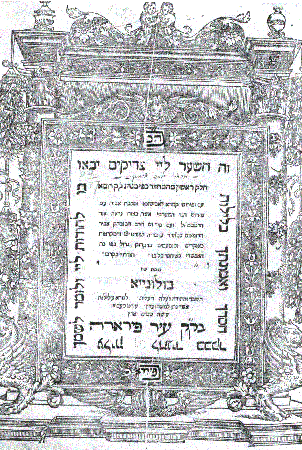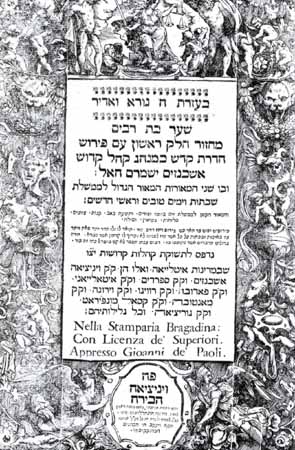Prayer Books: Early Printed Prayer Books
As in so many beginnings in Hebrew printing, the Soncinos were first again. The Soncino family printed the first complete Hebrew Bible and the first tractates of the Talmud, and in the first month of the year 5246 AM (September 10-October 9, 1485), B'nai Soncino (the Sons of Soncino) began the printing of the first Hebrew prayer book, Mahzor Minhag Roma (A Prayer Book of the Roman Rite), in the city of Soncino. in the Ashkenazi tradition, a mahzor contains only holiday prayers; the Sefardim use the term mahzor to mean a prayer book containing the entire liturgy-daily, Sabbath, and holiday. The Soncino mahzor is such a comprehensive one and took almost a year to complete. Part of the reason it took so long was that in the process the press had to be moved-a sudden, forced moveto the town of Cassalmaggiore, where the mahzor was completed on "the second day of the week [i.e., Monday], the twentieth day of the month of Elul, in the year 5246 Am [August 21, 1486]." Of this edition David W. Amram wrote in his The Makers of Hebrew Books in Italy:
A bulky volume is this first Soncino edition; found entire only when pieced together from stray fragments and pages by the care and knowledge of the booklover. It seems especially to have aroused the ire of the Inquisitors, for its destruction is almost complete; of the copies extant all bear traces of the hand of its foes, and torn pages still further defaced by the ink scrawl of the censors are eloquent in their silence.
The Library has a fine copy of Volume 2, the first Hebrew book printed in Cassalmaggiore. The censor's blotting out of words and phrases throughout the volume does not deface it; it adds a silent majesty to it, particularly so because the censor's ink has faded, while the printed letters he sought to erase endure in all their clarity.
 |
The last of the five services of worship on the Day of Atonement, Ne'ilah, a supplication, is printed in letters twice the normal size. One assumes this was done because this service is at twilight, and the editor-printer wanted to be sure it could be read-and because it is a message of hope. The prayer begins with:
Thou stretchest forth thy hand to the wicked, and thy right hand is extended to receive those who repent ...
and concludes with:
Thou desirest the repentance of the wicked and not their death, as it is written: "Have I any desire, says the Lord, for the death of the wicked man? Would I not rather that he should mend his ways and live?"
Thirty-five years later, Gershom Soncino printed a new edition of this mahzor, to which he added "penitential prayers, supplications and readings sweeter than honey." In it he reprints the colophon of the first edition written by his grandfather, Israel Nathan, "the father of all the Soncinos," who likened the mahzor he had published to a "ladder set up on earth whose top reaches unto heaven upon which we may ascend to supplicate our Maker, blessed be He." Gershom writes a colophon of his own, which concludes with:
Praise be to God who has not withheld his Mercy from us. His left hand casts us off, but His right brings us nearer to him. So may He, in His mercies, sustain our souls and grant us life among those who do His will. This book was completed in the city of Rimini, which is under the dominion of Pope Leo X, may his glory be exalted, this 21st of March, corresponding to Nisan 13. Praise to the Lord, to whom blessing is due, and glory to His great Name.
Leo X was the most benevolent of pontiffs, whose reign was a happy one for the Jews. He permitted Elijah Levita to establish a Hebrew press in Rome, and Daniel Bomberg to print the Talmud. His benevolent attitude influenced the Ecclesiastical Council of Rimini to permit Gershom Soncino to establish a Hebrew press in that city, and Soncino is grateful for it.
 |
Among the liturgical oddities in the Library is a pamphlet published in Venice, 1792, A Prayer ... in Ferrara ... for the life of our sovereign king, the Pope. The prayer, to be recited at every daily minha (afternoon service), except on the eve of the Sabbath or a holiday, is for Pope Pius VI. Of him Cecil Roth, in his article on popes in the Encyclopaedia Judaica, writes:
Pius codified, reinforced, and intensified the whole of former, degrading anti-Jewish legislation, however barbarous it was, and went so far as to forbid Jews from passing the night outside the ghetto, under the pain of death.
A large pulpit-sized edition of the Roman rite mahzor was published in Bologna in 1540, accompanied by what was meant to be a popular commentary, as its author Johanan Treves explains:
[I] did not invent anything, but gathered from existing authors ... as the gleaner follows the harvester ... I did not seek to produce fine flour, but flour made from roasted ears [in Aramaic Kimha de-Avishuna, the title of the work].
The Library of Congress copy was formerly in the Great Synagogue of Ferrara, as is indicated in manuscript on the ornate title page, and also noted on the first page.
 |
An even larger, grander edition of the Ashkenazi mahzor, containing the liturgy for "the Sabbath, the Holidays, the New Month as well as for Purim, Tisha B'Av ... the wedding ceremony and circumcision," was published in three large volumes in Venice in 1711. Its title page is ornate, in the grand Italian style. Its publishers, Joseph and Jacob Hai Cohen, announce that their prayer book is published for the congregations in Venice: the Ashkenazi, the Sefardi and the Italian; as well as for those of Padua, Rovigo, Verona, Mantua and Casale Monferrato, Gorizia, and their environs. The special authorizations are printed in very large letters on the first two pages; that of the Padua authorities stipulates that as many copies as were published in 1600 may now be published, and the other grants a copyright for twelve years. Approbation by leading rabbis affirms the twelve-year period during which no other editions may be published. The publishers had spent a huge sum of money for so grand a publication and wanted to protect their investment. The Library's copy, bound in parchment, is in such pristine condition that either it was handled with the greatest reverence or was little used.
 |
Sources: Abraham J. Karp, From the Ends of the Earth: Judaic Treasures of the Library of Congress, (DC: Library of Congress, 1991).


